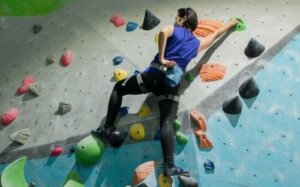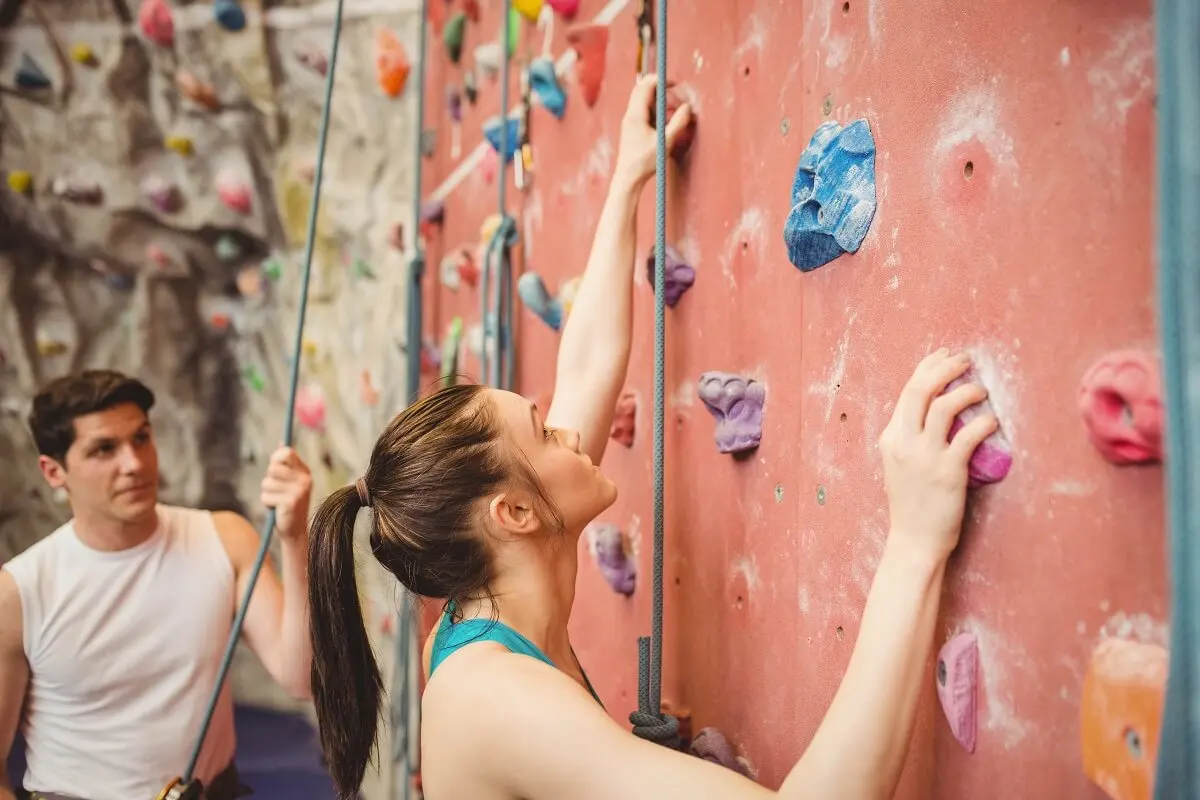Everything You Need to Know to Improve Your Wall Climbing Skills

Wall climbing, also known as bouldering, has advanced from being a hobby to an Olympic sport. Although this sport isn’t limited to major competitions, those who take it up as training need to prepare themselves to demonstrate physical results and reduce the risk of accidents.
This exercise is great for your health and contributes to the increase of muscle resistance. However, these effects are only possible if climbers execute a good technique and comply with the proper training. Let’s take a closer look at what this involves.
What is wall climbing or bouldering?
Bouldering enthusiasts find the opportunity to exercise with a discipline of their liking, without the need to resort to natural walls by using indoor walls or those found in parks.
The basis of wall climbing is to climb walls prepared with routes that serve as steps and are adjusted with pieces on the wall. Athletes can climb fixed routes known as ‘problems,’ according to USA Climbing.
These ‘problems’ are distributed on a 4.5-meter-high wall; on the lower base of the climbing wall are mats that cushion potential falls. The goal is to reach the last hold of the top with both hands.
The Spanish Federation of Mountain Sports and Climbing specifies that there are 3 modalities of bouldering: block, difficulty, and speed. The combination of these determines the level when it comes to competition.
Although this is a high-intensity activity, it only involves 4 to 6 movements – the number of times the athlete grabs a hold. In addition to agility, strength, flexibility, and balance are required.
The benefits of bouldering include calorie burning, better balance and agility of thought.

What could affect your performance while wall climbing?
Without mental and physical conditioning, it’s difficult for climbers to excel. Concentration on the climb is essential and attention must be paid to foot skills. Keep in mind that it’s the feet that support much of the weight for climbing, taking energy work away from the upper body.
On the other hand, focus is key to accelerating the arrival at the top. What does this mean? Well, it’s a good idea to study the prey with your eyes, so that the positioning is not clumsy. It helps to see further down because you understand the shape and layout of the holds.
An extra factor that detracts from competitive bouldering training is practicing on resin walls, whose design is far from what a rock really is.
If the size and configuration of the holds are unrealistic, this affects your technique. This kind of climbing wall is acceptable for entertainment, but counterproductive if you want to measure your results.
We think you may be interested in reading this, too: How to Get Jack Grealish Calves? The 5 Best Exercises to Achieve It
Recommendations for improving bouldering technique
The International Journal of Sports Nutrition and Exercise Metabolism states that the main objectives of bouldering include optimizing anaerobic capacity and developing strength.
To improve your performance, bouldering requires nutritional support that influences the power-to-weight ratio and limits the load on your limbs.
The article discusses adequate carbohydrate availability and supplementation with b-alanine and creatine to maximize anaerobic endurance in a way that supports the climbing method. Here are some other tips.
Master your footwork
Sharpening your toes on holds helps you climb with agility and slows muscle fatigue in the arms. Likewise, always aim for short strides and, as long as you sense balance, resort to toe-curling footfalls, followed using your big toe area.
In the process, keep your toe in sight until you push off the leg or straighten the knee.
It’s crucial to wear appropriate footwear for this discipline, known as “cat feet”, which are made to be malleable, light, and adherent.
Rehearse the drop knee move
How is this done? Put one foot on the fulcrum and turn your knee so that it points downward. Chile Climbers argue that the lolot or drop knee move is a tactic to keep your center of gravity glued to the wall in order to take the weight off your hands.
Embed your knee
Wogu Climber details that to embed your knee, you should place the foot and knee between 2 rock surfaces; in the case of bouldering, this is equivalent to a pair of holds. Then, push with the sole of your foot in an action similar to stepping on the accelerator of a car.
When you embed, you rest your arms and fuel a recovery that can propel the rest of your climb.
Look for a grip
When you hit smooth support, always look for a grip. The science is to take advantage of the contact surface and propel yourself, always with a relaxed heel.
Train your instep
In climbing, the instep is a hook technique that can be executed on the edges of the wall while taking advantage of large holds. The way to do this is with traction and thrust of the upper foot, flexing the knee, while your second foot stays down creating the hook and extending this knee a little more.
Train your heel
The heel strategy consists of stepping into a sizeable support, where the heel can rest comfortably and all your weight falls on it.
Learn to use your arms and fingers
Good use of the musculature activates the arms, advances your movements, delays fatigue, and minimizes the likelihood of injury. For each movement of one hand, stretch the opposite arm, thus simplifying the lift and using more strength from the legs.
As for your fingers, it’s best to use an open grip, because this reduces the risk of injury. You apply it by flexing the angle of the interphalangeal joints to catch the holds.

Like this article? You may also like to read: Discover the Importance of Keeping a Day Off Your Exercise Routine
Preparing for wall climbing performance
As with other sports disciplines, climbing requires a general warm-up to increase endurance. Consider pre-workouts that include dynamics such as the following:
- Climbing in easy areas: Start with easy routes that allow you to work on your balance and follow your intuition.
- Turn on your feet: Position each foot on a hold, facing the same side. Turn your body, but take your feet in the opposite direction to the initial one. Repeat this several times, being careful not to fall.
- Core exercises: The University of Palermo explains that core exercises are exercises included in strength training, ideal for toning difficult muscles such as the biceps and triceps. This kind of routine benefits climbing, as it promotes foot and hand technique, endurance, energy management, and breath control.
A bonus: The therapeutic effects of wall climbing
A scientific experiment published by BMC Psychiatry proposes indoor rock climbing as a possible treatment for depression. The experts studied a group of climbers for two months, who were measured for depression prior to the practice.
At the end of the test phase, they noted positive changes in the participants, suggesting that rock climbing could help to treat the disease. However, further research is needed.
In conclusion, whether for entertainment or for competitive interest, rock climbing promotes physical and emotional health, so why not give it a try?
All cited sources were thoroughly reviewed by our team to ensure their quality, reliability, currency, and validity. The bibliography of this article was considered reliable and of academic or scientific accuracy.
- Burgman, J. Boulder sin cuerdas. Ningún problema. Climbing Magazine. https://usaclimbing.org/climb/bouldering/
- Chile Climbers. (2018). Aprende de Magnus Mitboe la técnica básica de pies que te ayudará a progresar. Chile Climbers. https://www.chileclimbers.cl/2018/11/22/aprende-magnus-mitboe-la-tecnica-basica-pies-te-ayudara-progresar/
- FEDME. ¿Qué es la escalada? Federación Española de Deportes de Montaña y Escalada. https://fedme.es/escalada/
- Luttenberger, K., Stelzer, E. M., Först, S., Schopper, M., Kornhuber, J., & Book, S. (2015). Indoor rock climbing (bouldering) as a new treatment for depression: Study design of a waitlist-controlled randomized group pilot study and the first results. BMC Psychiatry, 15(1). https://doi.org/10.1186/s12888-015-0585-8
- Smith, E. J., Storey, R., & Ranchordas, M. K. (2017). Nutritional considerations for bouldering. International Journal of Sport Nutrition and Exercise Metabolism, 27(4), 314–324. https://doi.org/10.1123/ijsnem.2017-0043
- Torres, I. (2020). Rodilleras, un paso más en la evolución de la escalada. Wogu Climbing. https://woguclimbing.com/rodilleras-paso-mas-evolucion-escalada/
- Universidad de Palermo. (2021). Fondos. Universidad de Palermo. https://www.palermo.edu/deportes/noticias16/1301fondos.html#:~:text=Los%20fondos%20son%20un%20ejercicio,son%20mucho%20m%C3%A1s%20que%20entrenamiento.
This text is provided for informational purposes only and does not replace consultation with a professional. If in doubt, consult your specialist.








